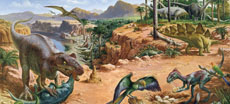 |
 |
 |
 |
 |
Produced
by the Population Genetics and Evolution class, Furman University |
||||
 |
 |
 |
 |
 |
Produced
by the Population Genetics and Evolution class, Furman University |
||||
 |
The
Jurassic: Hadrocodium |
 |
||
| Hadrocodium
is the earliest known mammal, differentiated from non-mammalian vertebrates
by its large brain and advanced ear structure. It is also one of the smallest
known mammals, with an estimated adult body weight of only two grams.
This incredibly small size would make sense for a large rate of morphological
innovations due to a high rate of reproduction (White 2005). Several suites
of mammalian apomorphies are observed. Inside the jaw, the lack of a concavity
and a postdentary trough suggests that the machinery of the inner ear
had already begun to move towards the cranium. Also, jaw articulaton is
moved anteriorly, spreading jaw musculature forward, allowing room for
a larger brain - likely due to the separation of hearing from eating (Luo
2001). Hadrocodium’s small size and large brain would most
likely have given it a very high metabolism. It would have had to eat
almost constantly, likely a diet of small insects and worms. This diet
is also backed up by its “triconodont-like” teeth, for insectivory
(Luo 2001). It is more closely related to the mammals of today then cynodonts
(mammal-like reptiles; White 2008). Page by Megan Aprill |
 |
| Hadrocodium. Picture From:darwiniana.org | |
|
Luo Z. 2001. A new mammaliaform from the early Jurassic and evolution of mammalian characteristics Science 292: 1535-1540 White AT. 2005. Hadrocodium. www.palaeos.com. Accessed March 28, 2010. White R. 2008. Evolution- Charles Darwin & A.R. Wallace.
Accessed March 28, 2010.
|